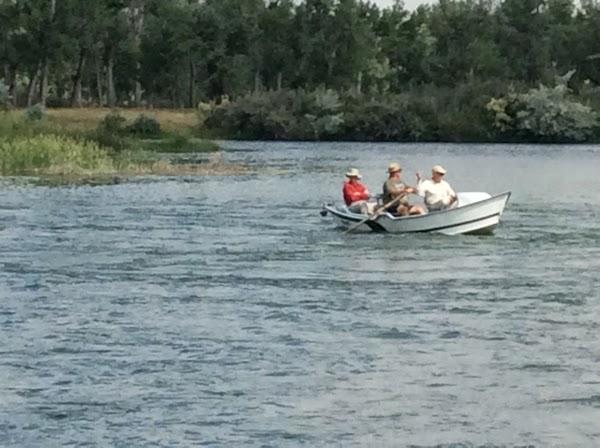So what makes this dam so famous for trout fishing? Turns out that most dams with bottom releases release cold water that is within the temperature range that trout need to survive. But this dam not only releases cold water, its alkalinity is also ideal for the growth of aquatic insects in such prodigious numbers that it can support a very healthy and fast-growing population of trout. Rainbow trout were introduced to the tailwater after the dam was built and they quickly flourished. Brown trout later found their way into this trout mecca from tributaries. Now the river supports impressive numbers of large rainbow and brown in the 18-20 inch range, with many much larger.
Of course Jack only has to catch one trout in this river to check it off his bucket list. So when we arrived in Saint Xavier we started looking for the river, as well as a place to stay. Turned out that this little village was about the size of Oriskany but with no place to stay. So we headed up river to mile 13 river access so Jack can see if he can wade-fish the stream. The river was obviously running high and was not wadeable. Jack had already researched and found a nice flyshop in Fort Smith near the dam which had guides and boats for fishing the river. So we headed upstream to the town and Jack signed up for an all-day guided boat trip down the river. Jack also bought his Montana Fishing License there and the folks told us of a nearby RV campsite.
Today (July 10th) we traveled back to Fort Smith so Jack could meet his guide. Carol took pictures and then returned to our RV campsite to work while Jack and his guide headed off for a day of fishing.
 | |
| The little town of Fort Smith is mostly flyshops and cabins for trout fisherman. |
 | |
| Jack chose this outfitter because they had a great website. |
 |
| Jack and his guide getting ready to go fishing. |
 | |
| Jack setting up his flyrod and placing his rain jacket in the boat. Jack says he brought his rain jacket as insurance that they would have a rain free day of fishing. (It worked!) |
 | ||||
| Carol making final inspection, to make sure everything is in order. |
We traveled not more than 100 yards before I catch my first fish. It's a huge (18-20 inch) brown trout. Brown trout ("Browns") in the wild are really beautiful and are known for their hard fighting and deep powerful runs. But this brown is jumping out of the water, so I think it is a rainbow trout, which are more known for their aerial acrobatics. This one puts up a big fight and makes several powerful runs which strips line from the reel and makes my reel sing. Only when we get the fish close to the boat do I realize it's a brown. As soon as the guide puts the net in to get the fish, the brown takes off again and again. Finally the guide nets the fish, removes the hook and lets the trout slip back into the water.
I'm elated! I can now check off this river. But the action has just started. By the time we have traveled two of the thirteen miles of our trip, I had caught so many brown and rainbow trout in the 18-20 inch range that I lost track. Already my arm was playing out from casting and fighting fish. By the time we reached mile sixteen, I was a hurtin' puppy. We waded in several spots and I got several big fish in every spot. Wherever Curt told me to cast, I caught big fish. This is the most fabulous river I have ever fished. I've been on rivers where I caught a lot of fish, but never on a river where the average size of the fish I caught was 18-20 inches. (I did catch one brown that was about 7 inches long.).
So why are the trout so large in this river? The answer lies in the limestone found in the canyon walls surrounding the stream. Limestone keeps the alkalinity of the river at a perfect level for the aquatic insects to grow. With so much food in the water, the trout grow rapidly and reach a big size. Spring creeks like the ones found in the center of Pennsylvania also have perfect alkalinity. But the trout there are hard to catch because the rivers are small. So the Big Horn is like a huge spring creek with plenty of deep water where the fish can feed and hide from predators.
For more information and many pictures, see the Bighorn Trout Shop website. This is the outfitter I used and my guide's name was Curt Olsen. Here are a few shots of the river I took later.
 |
| This shot was taken at the Mile 3 access point. A lone fisherman is trying his luck from the bank while two boats with guides float by, |


This is so interesting! Congratulations, Jack. Have you read "A river runs through it" by Norman Maclean, about family relationships and fishing on the Missoula? The movie was excellent; the book is even better.
ReplyDelete